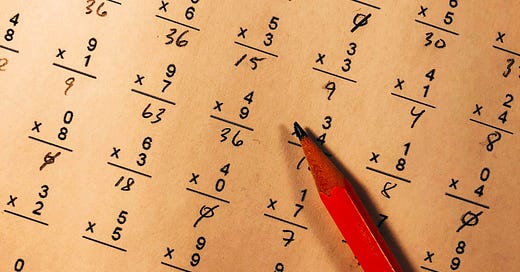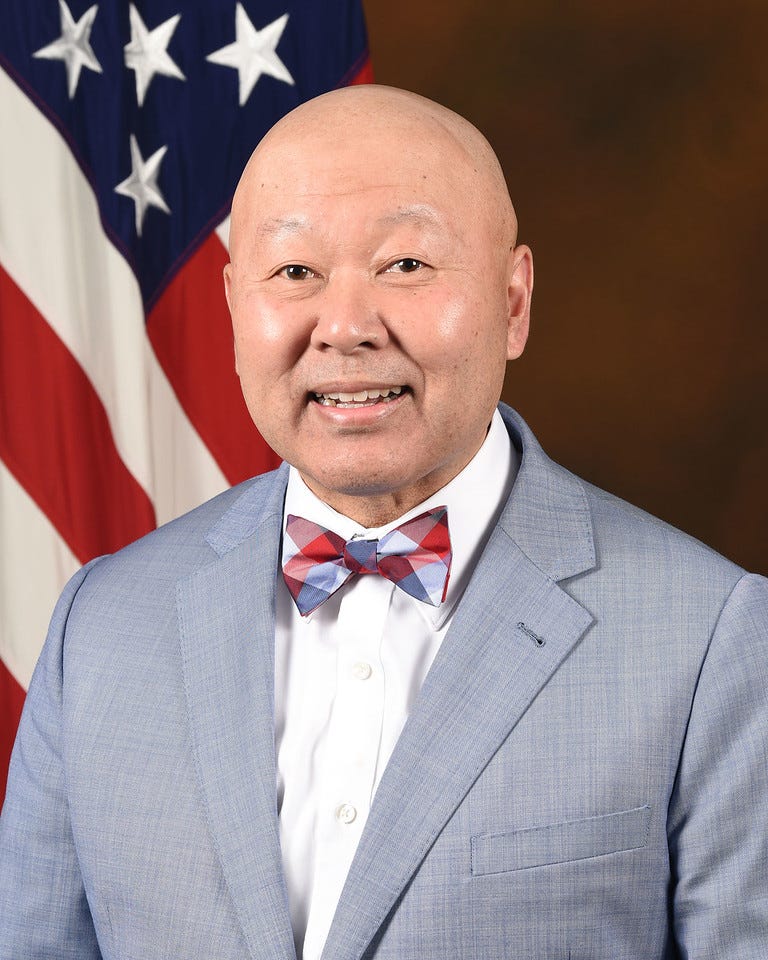As an Amazon Associate I earn from qualifying purchases
When average people think about classical education, they tend to think about students reading the great works of Western civilization such as Homer’s Iliad and Odyssey. Those same people probably do not think about mathematics and its classical origins, yet it is the movement away from mathematics’ classical heritage that has helped cause the collapse of mathematical learning in America’s schools.
One of the most important foundational elements of mathematics is the standard algorithm, which is a step-by-step process that will solve a class of mathematical problems.
For example, the standard algorithm for addition is a method of adding two or more numbers by aligning them vertically, column by column. Thus:
In the standard algorithm for addition, digits in the right hand (ones) column are added first, and then there is a carryover of any tens into the next (tens) column to the left where the numbers in that column, including the carryover, are added.
The origins of standard algorithms, however, are often forgotten.
The great ancient Greek mathematician Euclid is famed for being the father of geometry, but he was also critical to the development of mathematical algorithms.
Euclid devised an algorithm using successive division and calculation of remainders to find the greatest common divisor (GCD) of two positive integers.
STEM writer Christopher McFadden, writing in the publication Interesting Engineering, used this example:
What is the GCD of 56 and 12?
Step 1—Divide the larger by the smaller number.
56/12= 4 (remainder 8)
Step 2—Divide the divisor by the remainder from the previous step.
12/8=1 (remainder 4)
Step 3—Continue step 2 until no remainders are left (in this case it’s a simple 3 step process)
8/4=2 (no remainder)
In this case the GCD is 4.
Dr. Sheueling Chang Shantz of Mountain View College has noted: “Euclid’s method of finding the greatest common divisor (GCD) of two integers was first described around the year 300 B.C. This simple iterative method is often regarded as the grandfather of all algorithms in Number Theory today.”
According to McFadden, “This algorithm is widely used for reducing common fractions to their lowest terms and in advanced mathematics applications such as finding integer solutions to linear equations.”
Why is Euclid’s algorithm still used today? Answer: because it works. If the step-by-step procedure is followed then the person trying to solve the problem will get the right answer in an efficient amount of time.
Writing in the New York Times, philosophy professor Alice Crary and math professor W. Stephen Wilson emphasized, “It is important to teach [standard algorithms] because . . . they are also the most elegant and powerful method for specific operations,” which “means that they are our best representation of connections among mathematical concepts.”
Critically, they point out, “Math instruction that does not teach both that these algorithms work and why they do is denying insights into the very discipline it is supposed to be about.”
Yet, despite the obvious effectiveness and efficiency of teaching students to learn and use standard math algorithms, progressive educators have done what they do best—destroy what works.
Although there have been various assaults on the use of standard math algorithms over the last decades, the Common Core national math standards, enacted by most states in the early 2010s at the prodding of the Obama administration, have not only torpedoed the broad and early use of the standard algorithms, but have helped sink student math achievement as a result.
Amazingly, Common Core does not require students to know the standard algorithm for addition until the fourth grade. Instead, students are taught to use convoluted, confusing, and time-consuming alternative strategies to arrive at an answer.
Barry Garelick, co-author of the book Traditional Math, explained, “Delaying teaching of the standard [addition] algorithm until the fourth grade and relying on place value ‘strategies’ and drawings to add numbers is thought to provide students with the conceptual understanding of adding and subtracting multi-digit numbers.”
Unfortunately, he noted, these alternative strategies are “inefficient cumbersome methods” that “confuse more than enlighten.”
“To teach the standard algorithm first,” he observed, “would in the reformers’ minds be rote learning.” There is nothing more poisonous to progressive educators than perceived rote learning, even if it works.
Cray and Wilson noted that these progressive reformists claim, “standard algorithms should be avoided” because “mastering them is a merely mechanical exercise that threatens individual growth.”
The implementation of this progressive philosophy in the classroom has frustrated children and appalled parents.
In an analysis of Common Core done for the Brookings Institution, education researcher Tom Loveless described a first grade math program that explicitly told parents not to teach the standard algorithm for addition to their children at home.
Loveless said that the school told parents that “students were being taught how to represent addition with drawings that clustered objects into groups of ten,” which was technique that was “both time consuming and tedious.”
“When the parents met with the school principal to discuss the matter,” reported Loveless, “the principal told them that the math program was following the Common Core by promoting deeper learning.” Not surprisingly, the parents exited their kids out of the school.
In my 2024 book The Great Classroom Collapse, I interviewed a Northern California professional math tutor named Mike Malione who described a similar experience with the students he tutored.
Malione said that the local schools in his area emphasized conceptual understanding over simple numerical operations using standard algorithms.
For instance, when children were asked to multiply two fractions, instead of simply multiplying the numerators and multiplying the denominators to get the right answer children were asked to draw pictures.
So, when given the problem of ½ x ¾, children were not shown that they could get the right answer by multiplying 1 x 3 and 2 x 4 to get 3/8.
Rather, he said that children were told by their teacher to draw a rectangle and split the rectangle into parts and then shade the parts to represent ½ and ¾ so that the shaded parts show “three parts out of eight to make the whole, so the whole thing is tied to looking at a picture and counting instead of just multiplying.”
Students are “supposed to be taught to draw the picture, so the idea is that as soon as you see a [fraction problem] you draw a picture.” But, he warned: “We’re going to draw a picture every time we’re given 10 problems with fractional multiplication, when you could do them in your head? We’re going to take time and draw 10 pictures and draw lines and shade? That’s insane.”
Not only is this instructional technique ineffective, it is also highly inefficient.
“It does take a long time,” he explained, “that’s a big problem and that’s why they had to remove all of this content [from the curriculum] because it takes so long that they ended up saying we have to remove this because it’s just too much.”
Malione lamented that he had students he tutored who “don’t remember how to multiply two-digit numbers because they have never practiced it enough,” and “the work is getting harder to the point that they don’t want to draw pictures every time.”
Students with weaker math skills “are the ones who are completely lost and they’re not getting the step-by-step guidance early on.” “They could be learning more in the early grades, but they’re not,” and “some are frustrated because they are struggling and they don’t know why.”
Malione said he finds that children who are struggling “could do just fine doing math the traditional way, and the traditional way helps them a lot.”
As Loveless has pointed out, standard algorithms are valuable because “they are efficient and packed with mathematics,” and once “students have mastered single-digit operations and the meaning of place value, the standard algorithms reveal to students that they can take procedures that they already know work well with one- and two-digit numbers, and by applying them over and over again, solve problems with large numbers.”
The movement away from teaching standard algorithms and traditional math methods has had disastrous consequences on student math achievement.
A federally funded multi-year study found that Common Core has had a significant negative impact on the math achievement of eighth graders and that this negative effect increased over time.
One can see the appalling outcome of Common Core and progressive math instructional methods and curricula in the recently released 2024 math scores on the National Assessment of Educational Progress, often referred to as the nation’s report card.
On the 2024 eighth-grade NAEP math exam, 72 percent of students taking the test failed to score at the proficient level, which was an increase of 6 percent over the 66 percent of eighth graders failing to reach proficiency in 2019.
Sadly, students who struggle with math in K-12 will struggle if and when they attend college.
For my book I talked to a college math professor in California’s Silicon Valley and he said that the lack of algebra knowledge is the number one deficiency in the calculus classes he teaches.
“That lack of preparedness,” he said, “just propagates up and up and up, even to the upper division classes where, without a curve, pretty much everyone would fail.”
So what is the solution to America’s math woes?
Traditional math advocate Sugi Sorensen, who is a top engineer at famed Jet Propulsion Lab and a math tutor, has urged schools to return to emphasizing the mastery of basic math skills and focusing on mastering standard algorithms.
He recommends that standard algorithms “such as the long division algorithm should be explicitly taught and practiced to mastery” before other alternate methods are taught. Specifically, “standard algorithms provide efficient and reliable methods for solving math problems.”
Further: “Another goal of traditional math instructors is automaticity—the ability to perform mathematical computations quickly, accurately, and effortlessly, without the need for conscious thought or extensive cognitive effort.”
Also, “The related ability to apply well-memorized procedures and algorithms smoothly and efficiently to solve novel problems is called procedural fluency.” Practicing math problems “is essential to developing understanding, achieving procedural fluency, cultivating accuracy, and extending learning beyond the classroom.”
These traditional math practices are used in high-performing math countries such as Singapore, South Korea, and Japan. Indeed, he points out, “the gap between Singapore and the U.S. is equivalent to three years of math education.”
“There is a moral here for progressive education that reaches beyond the case of math,” concluded Cray and Wilson. They explained:
Even if we sympathize with progressivists in wanting schools to foster independence of mind, we shouldn’t assume that it is obvious how best to do this. Original thought ranges over many different domains, and it imposes divergent demands as it does so. Just as there is good reason to believe that in biology and history such thought requires significant factual knowledge, there is good reason to believe that in mathematics it requires understanding of and facility with the standard algorithms.
American policymakers, therefore, face crucial questions. Do we simply acquiesce to the status quo of ineffective progressive math education in our schools, with the result that our country fails to produce enough homegrown STEM talent to staff companies in our high-tech economy? Or do we commit to a drastic overhaul of the way math is taught to our children and go back to doing what works?
We know what Euclid would do.
Lance Izumi is senior director of the Center for Education at the Pacific Research Institute and a former president of the Board of Governors of the California Community Colleges. He is the author of the PRI book The Great Classroom Collapse: Teachers, Students, and Parents Expose the Collapse of Learning in America’s Schools.






